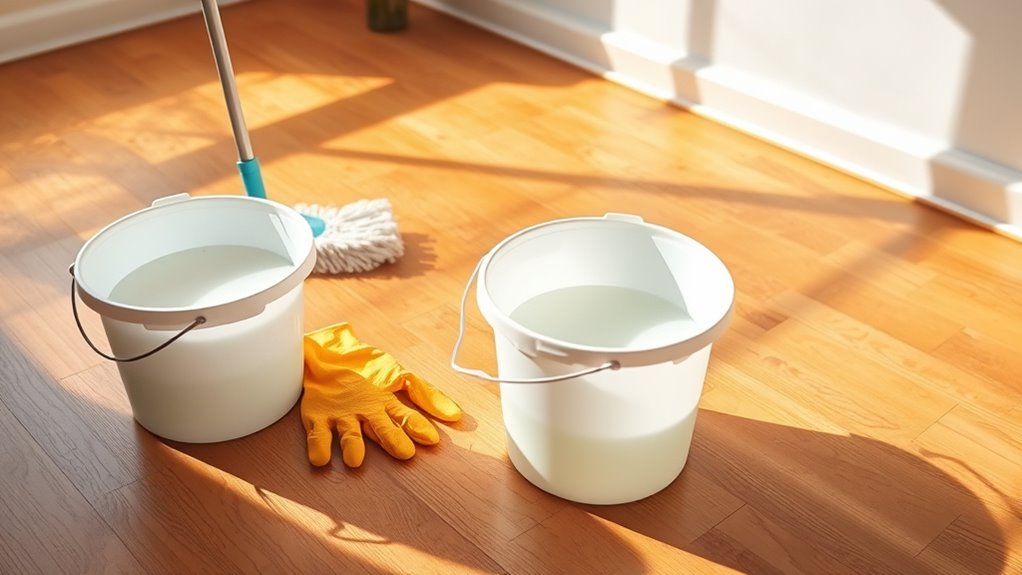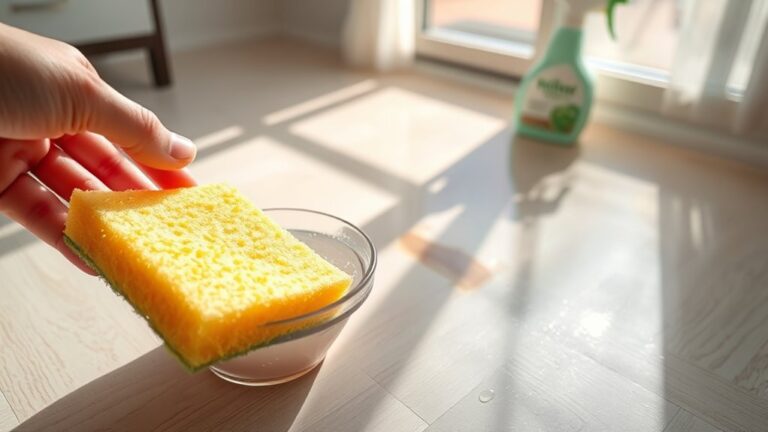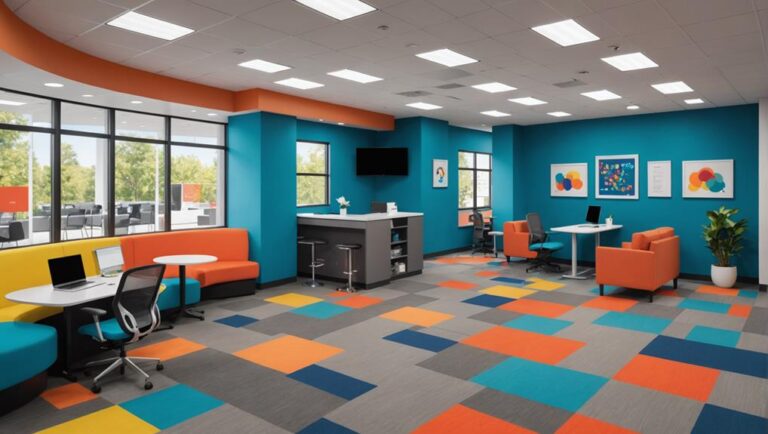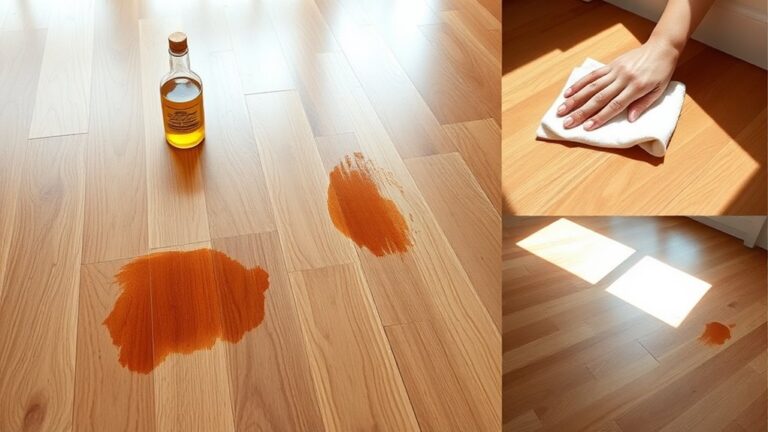You can use bleach safely on hardwood floors by diluting one part bleach with at least ten parts water to avoid damage. Start by cleaning and drying the floor thoroughly, then apply the solution gently with a damp mop or cloth. Rinse immediately to remove residue and dry completely to prevent warping. Always test a hidden spot first, and avoid strong or prolonged exposure. Following these steps can help maintain your floor’s finish and durability; practical tips and alternatives can further guide you.
Understanding the Risks of Using Bleach on Hardwood Floors
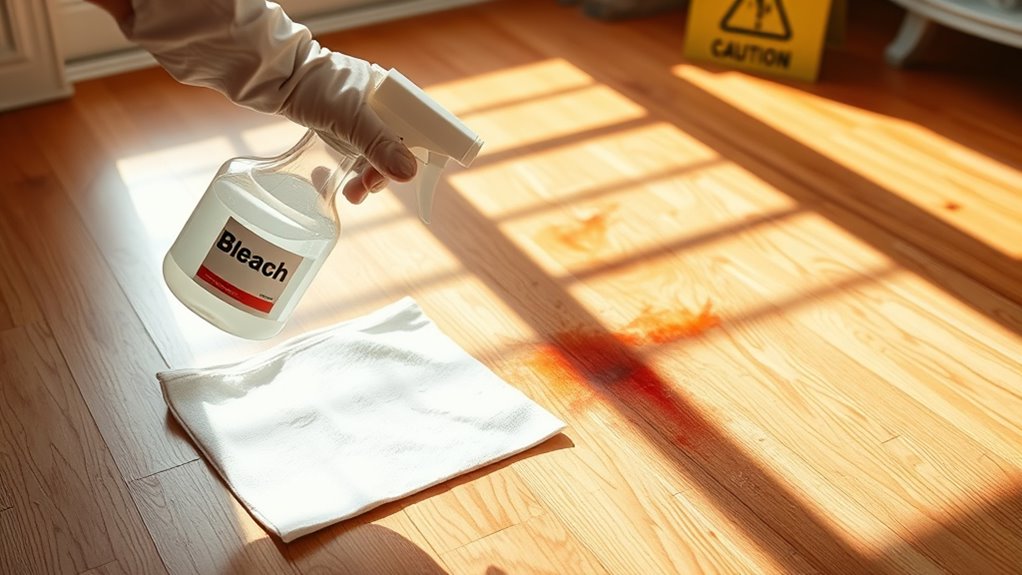
Although bleach is a powerful disinfectant, using it on hardwood floors can pose significant risks to their finish and structural integrity. You might be tempted by bleach effectiveness against germs, but harsh chemicals can strip or discolor your hardwood finish, leaving it dull or damaged. Excess moisture from bleach solutions can seep into seams, causing warping or swelling over time. If you want to maintain your floor’s natural beauty and durability, you need to weigh these risks carefully. Bleach isn’t designed for hardwood’s delicate surface, so applying it without proper caution could cost you freedom from repairs and refinishing. Instead, consider safer alternatives or diluted solutions and always test a small area first to protect your investment and enjoy lasting results.
Preparing Your Hardwood Floor for Bleach Cleaning
Before you apply bleach to your hardwood pavimento, you need to prepare the surface properly to minimize damage. Start by gathering your cleaning essentials: a soft broom or vacuum, a microfiber mop, bucket, gloves, and a well-ventilated workspace. Begin floor preparation by thoroughly removing dust, dirt, and debris using your broom or vacuum—this prevents scratches during cleaning. Next, mop the floor with a mild detergent solution to eliminate surface grime. Make certain the floor is completely dry before moving on. Clear the area of furniture and rugs to access all spots evenly. Proper floor preparation helps bleach work effectively while protecting your hardwood. Taking these steps guarantees you maintain your freedom to clean safely without risking permanent damage.
How to Dilute Bleach for Safe Application
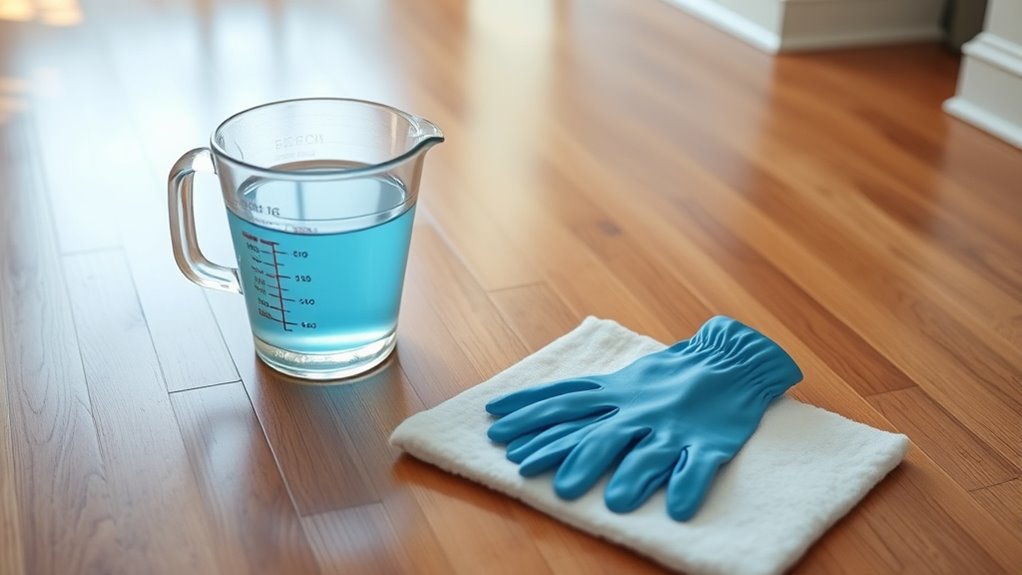
A small amount of bleach goes a long way when cleaning hardwood floors, so it’s important to dilute it properly to avoid damage. You’ll want to use proper measurements to create a safe, effective solution—typically, one part bleach to ten parts water. Using too much bleach can harm your floor’s finish, while too little won’t disinfect properly. After mixing, make certain of safe storage of any leftover diluted bleach in a clearly labeled container, away from children and pets.
| Bleach (cups) | Water (cups) | Use Case |
|---|---|---|
| 1 | 10 | Pulizia generale |
| 0.5 | 10 | Light stains |
| 2 | 20 | Larger areas |
| 1 | 15 | Sensitive surfaces |
Stick to these ratios for safe, effective cleaning.
Step-by-Step Bleach Cleaning Process for Hardwood Floors
Before you start, make sure to clear and clean the floor to remove any dirt or debris. Next, dilute the bleach properly to avoid damaging the wood. Finally, apply the solution carefully and rinse the area thoroughly to protect your hardwood floors.
Preparing the Floor
Since hardwood floors are sensitive to harsh chemicals, you’ll need to prepare them carefully to avoid damage when using bleach. Start by removing all furniture and rugs to clear the area completely. Sweep or vacuum the floor to eliminate dust and debris that could scratch the surface during cleaning. Gather your cleaning tools—use a soft-bristle broom, microfiber mop, and buckets for rinsing. Before applying bleach, assure proper floor protection: cover baseboards and adjacent walls with painter’s tape or plastic sheeting to prevent accidental splashes. Also, ventilate the room by opening windows or using fans. Taking these steps gives you control, reducing the risk of damage and allowing you to clean confidently and safely. Proper preparation sets the stage for effective bleaching without compromising your hardwood’s finish.
Diluting the Bleach
With your hardwood floor properly prepared, the next step is to dilute the bleach correctly to confirm safe cleaning. Maintaining a proper bleach concentration is essential to protect your floor’s finish while disinfecting effectively. Here’s how to achieve safe ratios:
- Use regular household bleach with 5–6% sodium hypochlorite.
- Mix one part bleach with at least ten parts water to create a 0.5% solution.
- Stir gently to guarantee even dilution without splashing.
- Always prepare the solution fresh before use to maintain potency.
Application and Rinsing
Although bleach is effective for disinfecting, you’ll need to apply it carefully to avoid damaging your hardwood floors. Start by using a soft mop or cloth dampened—not soaked—with the diluted bleach solution. This application technique prevents excess moisture from seeping into the wood, which can cause warping or discoloration. Work in small sections, applying the solution evenly and gently.
After allowing the bleach to sit briefly (no more than five minutes), immediately use a clean, damp mop with plain water to rinse the area. Effective rinsing methods remove any bleach residue that could harm the finish or wood fibers. Finally, dry the floor thoroughly with a soft towel or fan to guarantee no moisture remains. Following these steps frees you to clean safely without risking your hardwood’s integrity.
Tips for Avoiding Damage During Bleach Use
Before using bleach on your hardwood floors, always test a small, hidden area to check for any adverse reactions. Make certain to dilute the bleach properly to avoid stripping the wood finish or causing discoloration. Taking these precautions helps protect your floors and guarantees a safer cleaning process.
Test in Small Area
One essential step you should never skip is testing bleach on a small, inconspicuous area of your hardwood floor. Spot testing helps you gauge how the wood reacts, ensuring you avoid irreversible damage. To effectively test areas:
- Choose a hidden corner or under furniture where damage won’t be obvious.
- Apply a diluted bleach solution with a cotton swab or small cloth.
- Wait 10-15 minutes to observe any discoloration or finish deterioration.
- Rinse the spot with clean water and dry thoroughly to check the true effect.
Dilute Bleach Properly
When using bleach on hardwood floors, you’ll need to dilute it carefully to prevent damage to the wood and finish. Proper dilution reduces bleach concentration, minimizing the risk of discoloration or warping. Typically, a safe dilution ratio for hardwood is 1 part bleach to 10 parts water. Always mix fresh solutions and avoid stronger concentrations unless specified for tough stains.
| Bleach Concentration | Dilution Ratio | Use Case |
|---|---|---|
| 3.5% (standard) | 1:10 | Pulizia generale |
| 3.5% | 1:5 | Macchie ostinate |
| 6% | 1:20 | Light disinfecting |
Stick to these guidelines to maintain your floor’s freedom from damage while achieving effective cleaning.
Protect Wood Finish
Properly diluting bleach is just the first step in protecting your hardwood floors. To preserve your wood finish and avoid damage during bleach use, follow these practical tips for wood finish maintenance:
- Test a small, hidden area first to verify the bleach won’t strip protective coatings.
- Avoid letting bleach sit on the surface; rinse thoroughly with water immediately after cleaning.
- Use a soft cloth or mop to apply bleach gently, preventing scratches or wear on the finish.
- After cleaning, apply a quality wood polish or wax to restore protective coatings and lock in moisture.
Alternative Cleaning Solutions for Hardwood Floors
Although bleach is effective for tough stains, it’s not always the best choice for hardwood floors due to its harsh chemicals. If you want to maintain your floor’s natural beauty without damage, consider eco friendly alternatives. Vinegar solutions, for example, are a popular option. Mix one part white vinegar with ten parts water to create a gentle cleaner that removes dirt and grime without stripping the wood’s finish. Just be sure to use a damp, not soaked, mop to avoid excess moisture. You can also try a mild dish soap diluted in water or commercial hardwood floor cleaners designed to be safe and effective. These alternatives let you clean thoroughly while preserving your freedom to enjoy beautiful, long-lasting hardwood floors.

